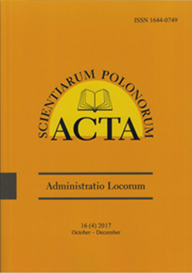AN ANALYSIS OF THE PERCEIVED LIVEABILITY INDEX
WITH THE USE OF ADJUSTED AND WEIGHTED ASPECTS BASED
ON A MULTI-STAKEHOLDER PERSPECTIVE IN THE INDONESIAN CITY
OF BALIKPAPAN
AN ANALYSIS OF THE PERCEIVED LIVEABILITY INDEX
WITH THE USE OF ADJUSTED AND WEIGHTED ASPECTS BASED
ON A MULTI-STAKEHOLDER PERSPECTIVE IN THE INDONESIAN CITY
OF BALIKPAPAN
Author(s): Saiful Ghozi, Ida Bagus Dharmawan, Dessy Handa Sari, Tizar M. Bijaksana, Suheriah M. DeviSubject(s): Welfare systems, Demography and human biology, Economic development
Published by: Wydawnictwo Uniwersytetu Warmińsko-Mazurskiego w Olsztynie
Keywords: perceived liveability index; Balikpapan; Analytic Hierarchy Process;
Summary/Abstract: Motives: Dynamic strategic issues have raised concerns about perceived liveability measurements to maintain a high quality of life that affects the residents’ wellbeing. Liveability aspects and indicators should be adjusted to accurately identify local issues and living conditions, and to promote community participation. Rigorous research methods with more representative samples are required to improve the accuracy of perceived liveability analyses in a specific context. Aim: The aim of this study was to measure the perceived liveability index in the Indonesian city of Balikpapan. The economic development of Balikpapan relies heavily on natural resources, and the city will be affected by the government’s plan to relocate the Indonesian capital. A survey involving both quantitative and qualitative methods was conducted to analyse perceived liveability in Balikpapan. The aspects and indicators of perceived liveability were adjusted and weighted based on a multi- stakeholder perspective to accurately represent the interests of all stakeholders when calculating the perceived liveability index using the Analytic Hierarchy Process (AHP). A content analysis of open- ended responses was carried out to analyse the feedback and the problems experienced by Balikpapan residents. The developed approach contributed to a better understanding of the residents’ opinions regarding the quality of life in the city. Results: Eight aspects of perceived liveability consisting of 51-item indicators were defined in this study. These aspects were arranged in the following descending order based on the values of theassigned weights: (1) access to basic utilities, (2) environment and health, (3) social development and security, (4) economy, (5) utility, (6) transport, (7) spatial development, and (8) recreation, culture, and public spaces. The analysis revealed that industrial and urban development in the eastern part of the city is inversely proportional to the perceived liveability index. In turn, urban development plans in the northern part of the city offer better prospects for new urban residents, economic actors, and stakeholders in the future residential design. The two major factors of perceived liveability, namely cleanliness and safety, indicate that the city effectively accommodates the needs of the existing residents, as well as potential migrants. Floods and poor road quality were identified as the most pressing problems in the city. According to the residents, economic problems and job insecurity were the main consequences of the COVID-19 pandemic. The results of this study can assist the local authorities in enhancing the capacity of urban policies or levels of policy implementation to meet the needs of local residents.
Journal: Acta Scientiarum Polonorum Administratio Locorum
- Issue Year: 22/2023
- Issue No: 2
- Page Range: 131-151
- Page Count: 21
- Language: English

